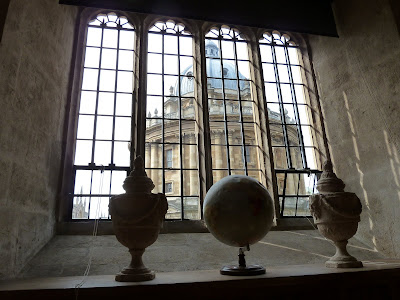This week I took a neighbour’s cousin from Pennsylvania by bus to Oxford, and guided her around the main places to visit there. We had a great day, and she was quite happy with how the day went.

I have been there several times, and wrote in more detail in my previous blogs: SEE Chapters 23 and 28.




 The entrance to The President's Residence is an example of understated "classiness" in its plain beauty.
The entrance to The President's Residence is an example of understated "classiness" in its plain beauty.

Wisteria festooning the student rooms and areas surrounding the Cloister. Across the Cloister to the Hall, with the Great Tower behind; the Tower was built in 1492-1509, and reaches 48 m into the sky.


Students celebrating the end of exams on the lawns in front of The New Building, built in 1733.


Some of the herd of 60 young deer in The Grove at Magdalen College. Deer have been here since 1705.

An ancient water pump at the edge of The Cloister, the original college quad.

One of the mostly brown-coloured windows in the Ante-Chapel. The whole effect is very peaceful, all the colours in the Ante-Chapel being subdued shades of brown, apart from a reproduction of The Last Supper on one wall.

Musically inspired carvings above the entrance to The Chapel itself.

Sculpture of Christ with Mary Magdalen, in the Chaplain’s Quad, beneath the Great Tower, the entrance to which is viewed through the sculpture.

The statue of Christ and Mary, created by David Wynne. An interesting effect is created by the holes in Christ’s hands.





Hanging in the Long Hall at Oxford is a portrait by Shee of Sir Thomas Andrew Lumisden Strange (November 30, 1756 – July 16, 1841) wearing a RED cloak. He was the first Chief Justice of the Supreme Court of Madras and in that capacity was also the first Chief Justice of the Madras Presidency, British India from 1801 to 1817. Earlier, from 1789–1797, he had been the sixth Chief Justice of Nova Scotia.
This bowler-hatted Christ Church Custodian showed us that as one walks down the dining hall keeping an eye on the portrait, the eyes and face clearly “follow” the walker as he or she passes the Strange portrait. Strange was the namesake of my maternal ancestor, Thomas Andrew Strange DeWolfe, born 1795, my 1st cousin, 6 times removed. It was his brother Elisha DeWolfe, Jr. who petitioned to have the name of the town changed from Mud Creek to Wolfville in honour of their father Elisha, who had been the Mud Creek (Horton) postmaster.








A single rose has been placed on The Shrine. It was built in 1289, destroyed in 1538 and rebuilt in 1889 and 2002. It once held the relics of St. Frideswide, the patron saint of Oxford.


Another stained glass window designed by Edward Burne-Jones, the Pre-Raphaelite artist, entitled Faith, Hope & Charity. It was made by the William Morris Company in 1871 and installed in Christ Church Cathedral.



Thousands of pine cones litter the paths and lawns beneath the giant J. R. R. Tolkien tree in the Botanic Gardens.





From his shoulder Hiawatha
Took the camera of rosewood,
Made of sliding, folding rosewood;
Neatly put it all together.
In its case it lay compactly,
Folded into nearly nothing;
But he opened out the hinges,
Pushed and pulled the joints and hinges,
Till it looked all squares and oblongs,
Like a complicated figure
In the Second Book of Euclid.
This he perched upon a tripod—
Crouched beneath its dusky cover—
Stretched his hand enforcing silence—
Said, “Be motionless, I beg you!’
Mystic, awful was the process.
--Lewis Carroll, Hiawatha’s Photographing, 1887


 I seek out the odd things, the small details, to muse about and photograph. A curious brace made of the figure of Pan.
I seek out the odd things, the small details, to muse about and photograph. A curious brace made of the figure of Pan. Another twisted view, of bent bicycle tyres on an abandoned one still chained to the fence.
Another twisted view, of bent bicycle tyres on an abandoned one still chained to the fence. An iconic Oxford building, the Radcliffe Camera, built 1737-1749. Now a reading room for the Bodleian Library.
An iconic Oxford building, the Radcliffe Camera, built 1737-1749. Now a reading room for the Bodleian Library.






At the end of the day, we made it to Oxford Castle to join the last tour for “Oxford Unlocked.” We climbed 101 steps to the top of the Saxon’s St. George’s Tower, with its great views of Oxford Town. (Unfortunately, it was up here that my camera’s lithium battery decided it had done enough for the day, and shut down. I have some serious questions for Panasonic since the battery only allowed me 160 photos!) Here, from the Tower we look at the castle 11th –century mound, built with stones and earth dredged from the river. A early castle tower originally stood here. After the tour, my fellow traveller and I climbed the winding pathway to the top.
Our guide was “The Prison Warder” a colourful character who carries the keys of the Oxford Castle cells, the castle being used as a prison from 1071 until 1996! Accommodations here were inhuman. In the olden days many prisoners died from typhus or “Gaol Disease.” There were also numerous executions—by hanging. We went into the Malmaison Oxford high-end hotel, created within some of the cell clocks of the old prison. For £170 I can book a Cell Standard with Shower; for The House of Correction, £150; for £385 I can get the Governor’s Suite. Some of these rooms come with the original prison bars; the whole thing is quite nice. We also visited the Castle Crypt--dank and dreary.
